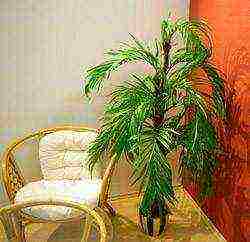Content
Home growing of mushrooms is becoming more and more popular every year. Unfortunately, not all varieties of mushrooms can be bred in this way, some of them are too capricious to the surrounding conditions, others require serious financial investments. Based on this, before you start mushroom growing on your own, you need to find out what mushrooms are grown at home. Most often these are the following types:
- Champignons (all varieties), volvariella, ringlet, raincoat, dung beetle. These are soil fungi, usually they grow in fields or meadows in the humus layer of the soil.
- Porcini mushrooms, chanterelles, boletus, boletus, truffles, morels, mushrooms. These are mycorrhizal fungi that form a symbiosis with the roots of only certain trees. They are artificially grown from purchased mycelium (mycelium is sprouted mushroom spores that are placed in a substrate), but it is rather difficult to breed these types at home.
- Oyster mushroom (all types - common, royal, pink, lemon), honey mushrooms (winter, summer, poplar, marble), gericium, tinder fungus, shiitake. These types of fungi grow on the wood of dead trees or plant debris containing cellulose.
The most unpretentious of all and the easiest to grow at home are oyster mushrooms, shiitake, winter mushrooms, mushrooms and ringlet.
All of these species have certain requirements for the conditions of detention. It remains only to figure out which ones.
 Oyster mushroom is in the first place in terms of prevalence and ease of cultivation. For novice mushroom growers, experienced entrepreneurs who have been engaged in mushroom growing for a long time offer to start growing mushrooms from it. When artificially growing oyster mushrooms, costs are required less than for all other mushrooms. Oyster mushroom is distinguished by unpretentiousness, excellent taste, early maturity, excellent yield, high resistance to viruses and bacteria, as well as rather long shelf life. Oyster mushrooms are grown in plastic bags (with a substrate, mushroom mycelium and bio-additives), on hemp, sawdust of various trees, straw, husk, corn stalks. Mushrooms grow well in rooms with a humidity of 80-85% and at fairly wide temperature ranges (from 10 to 30C, average values 16-20C). The first harvest of mushrooms can be cut after 30 days (in winter after 45). From one mushroom block at a time, it turns out to remove an average of 2.5-3 kg of the crop. At the same time, serve 100 blocks on an area with an area of 30 sq. m. without problems even one person can. Mushrooms produce a harvest for 5 years.
Oyster mushroom is in the first place in terms of prevalence and ease of cultivation. For novice mushroom growers, experienced entrepreneurs who have been engaged in mushroom growing for a long time offer to start growing mushrooms from it. When artificially growing oyster mushrooms, costs are required less than for all other mushrooms. Oyster mushroom is distinguished by unpretentiousness, excellent taste, early maturity, excellent yield, high resistance to viruses and bacteria, as well as rather long shelf life. Oyster mushrooms are grown in plastic bags (with a substrate, mushroom mycelium and bio-additives), on hemp, sawdust of various trees, straw, husk, corn stalks. Mushrooms grow well in rooms with a humidity of 80-85% and at fairly wide temperature ranges (from 10 to 30C, average values 16-20C). The first harvest of mushrooms can be cut after 30 days (in winter after 45). From one mushroom block at a time, it turns out to remove an average of 2.5-3 kg of the crop. At the same time, serve 100 blocks on an area with an area of 30 sq. m. without problems even one person can. Mushrooms produce a harvest for 5 years.- Champignons occupy the next place in terms of the popularity of cultivation, both in an industrial economy and at home. They are much more demanding on the conditions of detention. And the technology of growing them is more expensive than breeding oyster mushrooms. Mushrooms are grown in bags or boxes with soil, in which the mycelium is laid. Champignons grow well in dark, cool rooms (12-18C, maximum value no more than 28C) with a humidity of 65-85%. The first harvest of mushrooms is ready for harvest in 45-50 days, and the next ones can be harvested within 3 months.
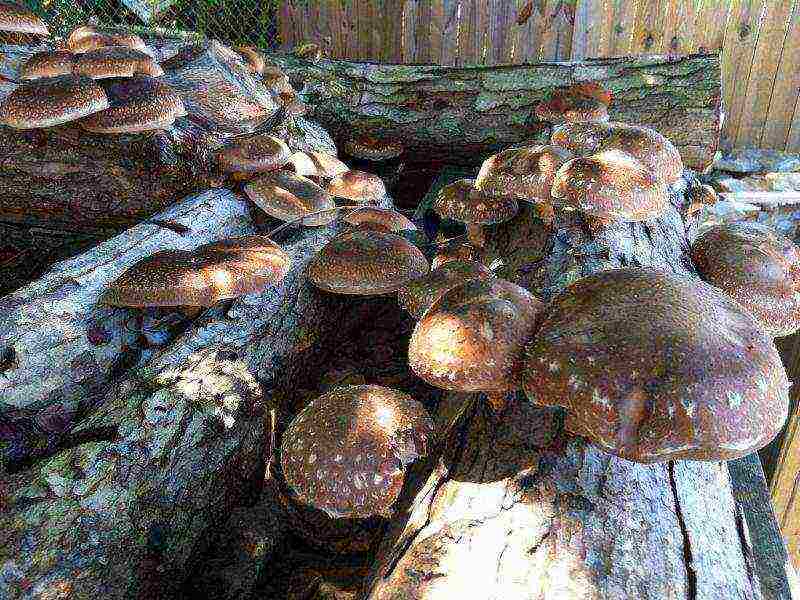 Shiitake - not only tasty, but also a very healing mushroom (successfully used in the treatment of cancer). Until a certain point, it was grown only in Asian countries. Shiitake is one of the most expensive mushrooms (the price is about $ 50 per 1 kg). Grows well at an average temperature of 12C. It is grown on sections of wood and on various substrates. It is important to know that in order to get a harvest of really tasty and healthy shiitake, the mycelium for breeding must be purchased from Japan or China, but not European, because it is spoiled by selection. The first harvest usually begins only in the next year and will last up to three years.
Shiitake - not only tasty, but also a very healing mushroom (successfully used in the treatment of cancer). Until a certain point, it was grown only in Asian countries. Shiitake is one of the most expensive mushrooms (the price is about $ 50 per 1 kg). Grows well at an average temperature of 12C. It is grown on sections of wood and on various substrates. It is important to know that in order to get a harvest of really tasty and healthy shiitake, the mycelium for breeding must be purchased from Japan or China, but not European, because it is spoiled by selection. The first harvest usually begins only in the next year and will last up to three years.- Winter honey - mushroom quite resistant to cold, grows well at ambient temperatures of 1-2 ° C. This mushroom has a pleasant taste and good nutritional value. It perfectly adapts to parasitizing on trees with living wood, and for this reason it should not be grown in backyard gardens or vegetable gardens, it is recommended to grow only on substrates and log cabins indoors.
- Koltsevik - not very well-known mushroom. Its cultivation began relatively recently, only about 25 years ago. This mushroom outwardly resembles a boletus, and in taste competes with champignons. It is grown on a personal plot directly on open ground beds or in plastic bags and boxes.
By becoming familiar with which mushrooms are grown at home, choosing a certain type for yourself and following the rules of caring for them, you will receive a constant tasty source of nutrients.
Wild edible mushrooms are a seasonal product. But recently, even in spring and autumn, it has become difficult to collect them. Frequent natural anomalies, droughts, early frosts leave connoisseurs of this product without their favorite dishes.
However, craftsmen found a way out by learning how to grow some types of mushrooms at home. Today they are happy to share their experience.
In what conditions can mushrooms be grown
To get a good harvest, any kind of mushroom needs to create certain conditions. In-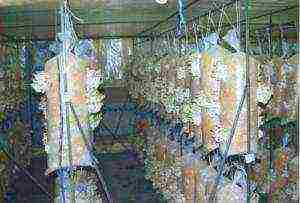 firstly, they need very high humidity, and secondly, during the fruiting period, the ambient temperature should be only 10-15 ° C. It is clear that this is impossible to achieve in an apartment. Of course, as a last resort, you can try to use the insulated balcony, but still, mushrooms will feel more comfortable in specially equipped sheds or basements. There they will be able to bear fruit up to 4 times a year.
firstly, they need very high humidity, and secondly, during the fruiting period, the ambient temperature should be only 10-15 ° C. It is clear that this is impossible to achieve in an apartment. Of course, as a last resort, you can try to use the insulated balcony, but still, mushrooms will feel more comfortable in specially equipped sheds or basements. There they will be able to bear fruit up to 4 times a year.
You can also grow mushrooms in your garden plots, but the result, as in the natural environment, will depend entirely on the weather. In addition, when planting myceliums in spring, you can get a crop only in autumn, and then under favorable weather conditions for growth.
A bit of terminology
A novice mushroom grower looking for useful information for himself suddenly comes across incomprehensible terms. What do they mean?
Mycelium - these are mycelium threads, roughly speaking, seeds, planting material.
Substrate - a specific mixture that provides mushrooms with the necessary nutrition for growth, development and fruiting. The substrate is usually placed in boxes or recesses in the ground, as well as on racks in specially equipped rooms.
The mycelium can be purchased in the store, but the substrate is made independently, and for each type of mushroom it has its own.
What types of mushrooms can be grown independently
Today, the range of online stores selling mycelium is surprisingly diverse. Believe it or not, you can grow more than 25 types of mushrooms at home! Although traditionally, the preference is given to champignons, oyster mushrooms, shiitake and porcini mushrooms. It is not surprising, these mushrooms are well known to everyone, have excellent taste, and are part of many dishes.
White mushroom. Agrotechnics
The substrate for growing porcini mushrooms can be prepared almost before planting the mycelium. For it, 5 liters of soil containing peat are mixed (you can use ready-made soil for indoor plants), 1 kg of wet sawdust of a coniferous tree, the same amount of fallen leaves. The mycelium is planted to a depth of 20 cm in prepared holes, the diameter of which is about 10 cm.The distance between these holes should be 30 cm.
Do not forget about regular moistening of the substrate, and then about a year after planting you can enjoy the first mushrooms, and in two years the yield will double. In general, such a mycelium can last up to 5 years.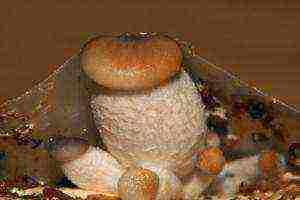
Champignons. Agrotechnics
Champignons are the most popular among mushroom growers. They are quite unpretentious and bear fruit perfectly even in the absence of any lighting. But the success of the cultivation is highly dependent on the correct preparation of the substrate. And it is prepared within a month on the basis of horse or cow manure and grain straw taken in equal proportions with the addition of mineral fertilizers: potassium superphosphate and ammonium nitrate.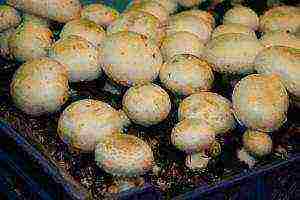
The finished substrate must be disinfected for three days. The composition of the disinfectant solution is extremely simple: 10 g of quicklime is added to 1 liter of water. After adding the solution, the substrate is stirred daily for 3 days. Then mycelium is evenly introduced into it.
As the substrate dries, it must be moistened with a spray bottle, and after a month, covered with plastic wrap with holes for air ventilation.
After complete overgrowth of the nutrient layer with mycelium, it is necessary to create a casing layer. To make it, 1 part of chalk powder is added to 9 parts of the finished raw soil for seedlings. This mixture is used to fill the substrate with mycelium by 2 cm. After a week, the cellophane film is removed. It is important to monitor thoroughly moistening the casing layer, and then the first fruits are formed in a month.
Oyster mushroom. Agrotechnics
Oyster mushroom is a high-yielding mushroom crop. Indoors, it bears fruit more often than once a month!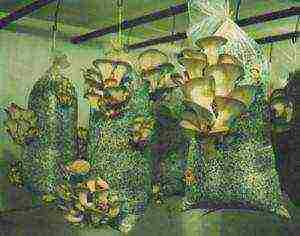
To grow oyster mushrooms, you need logs of medium diameter and about half a meter long with bark, but without branches and areas of rot. It is necessary to cut these logs from healthy hardwood trees one month before working with them. In a checkerboard pattern, at intervals of 20 cm, holes about 5 cm deep are drilled in the wood, where the planting material is placed. After that, the holes are covered with sawdust, and the log is buried by one third into the ground. Watering can be carried out both on the ground and on the wood itself 2 times a week. In a maximum of six months, the first mushrooms will begin to appear. When keeping wood outdoors for the winter, it must be insulated by sprinkling with fallen leaves.
In addition, oyster mushrooms can be grown in a substrate from various plant waste, such as sawdust of deciduous trees, husk of sunflower and cereal crops, corn silk and crushed cobs, and so on.
Shiitake. Agrotechnics
Shiitake is a crop successfully cultivated all over the world. For its cultivation, wood is needed, prepared in the same way as for oyster mushrooms. The only difference is that the logs must be 2 times longer. There are also some other points of difference in agricultural technology, namely, 3 months after the mycelium is populated into the wood, one side of the log must be placed in water for 12 hours. After that, the log is installed at an angle in a well-lit place, and after two weeks the rudiments of the mushrooms will already be visible.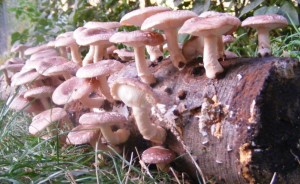
At first glance, the process of growing mushrooms on your own may seem quite laborious, but this is not entirely true. If you specialize in the cultivation of one or two types of mushrooms, experience is gained quickly enough, and the yields become invariably high.
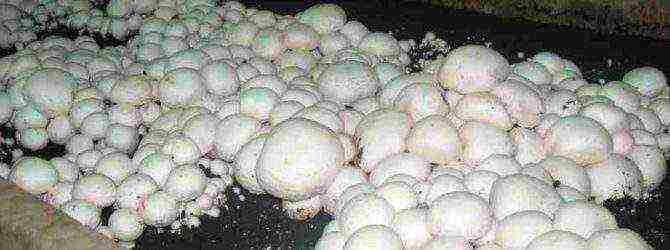
With some effort, you can grow edible mushrooms on your site. Recently, an increased interest in mushrooms growing under supervision is associated with a poor ecological situation and frequent poisoning by mushrooms collected in the forest.
The most unpretentious of the mushrooms used for this purpose are considered: oyster mushroom, ringlet, winter mushroom, champignons and shiitake. For the cultivation of these mushrooms, a previously prepared special substrate is used, which consists mainly of mineral components and plant residues.
Oyster mushroom
This is the most economically profitable and unpretentious mushroom, they are grown in the country, at home, in an ordinary city apartment, for example, you can grow a small amount of mushrooms on a windowsill in a special greenhouse, and you can even create a small production. This mushroom contains a large amount of polysaccharides, oyster mushroom contains 2 times more of this substance than chanterelles and four times more than champignons. In the composition, the amount of essential amino acids is much higher than in vegetables, grains and nuts, almost the same as in milk and meat. The nutritional value of the mushroom is literally invaluable due to the components that bind the carcinogenic substances to a part, of which they provoke cancer. Numerous studies have proven that the inclusion of oyster mushrooms in the diet, which contains a lot of lovastin, is a good prevention of the development of multiple sclerosis, diabetes and tumor diseases.
Champignon
A delicacy mushroom, which many know from childhood, it is not very difficult to grow it in a summer cottage or a personal plot from late spring to early autumn, and using a greenhouse or closed premises - all year round.
Shiitake
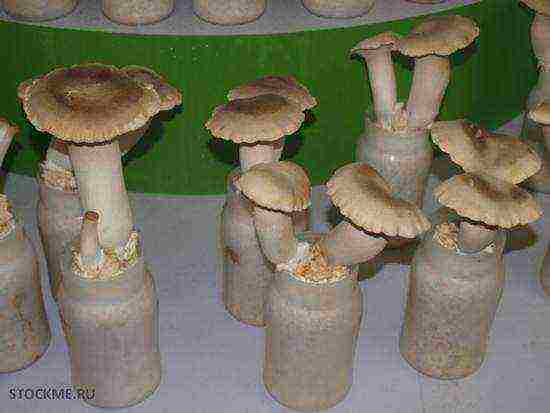 Grown in damp and darkened rooms, you can use sheds and basements for this. Shiitake is distinguished by its wonderful taste and many medicinal qualities. This is one of the most expensive home-grown mushrooms in the world (for 1 kg they give up to 50 dollars) Fruiting of the mushroom continues until the wood used as a substrate is completely destroyed. Intensively, this mushroom is grown using mycelium introduced into a specially formulated substrate, which includes sawdust, and additions of gypsum and chalk.
Grown in damp and darkened rooms, you can use sheds and basements for this. Shiitake is distinguished by its wonderful taste and many medicinal qualities. This is one of the most expensive home-grown mushrooms in the world (for 1 kg they give up to 50 dollars) Fruiting of the mushroom continues until the wood used as a substrate is completely destroyed. Intensively, this mushroom is grown using mycelium introduced into a specially formulated substrate, which includes sawdust, and additions of gypsum and chalk.
Winter honey
This mushroom is similar in composition to shiitake mushrooms. Winter honey agaric can be grown on window sills for this it received the name - winter flower, because against the background of white snow outside the window, painted in beautiful colors from milky to light brown look very beautiful. This is one of the most cold-resistant mushrooms, it can be grown at a temperature not lower than 1 - 2 degrees. In nature, it grows on almost all continents, it can be found in late autumn, often even after frosts, or during a long winter thaw.
There are more than enough mushroom lovers in our country! Only for a hike into the forest for a "quiet hunt" you need the accompanying weather and certain climatic conditions. Not everyone will think about growing mushrooms at home, and even almost on an industrial scale. Most consider this to be fantastic. However, everything is real. And we will tell you how to grow mushrooms in a greenhouse or at home.
What mushrooms can be grown at home
The very idea of growing mushrooms at home poses a choice of a specific species. All varieties suitable for home breeding do not need special material costs or additional efforts. The only exceptions are champignons, but an experienced gardener will cope with this problem. The choice must be made, first of all, based on the desired profit. All varieties of mushrooms suitable for growing at home can be classified into two main types:
- woody;
- soil.
The former include the well-known shiitake mushrooms, oyster mushrooms, and winter mushrooms.But to the second - no less popular mushrooms and ringlets. Even with small areas, the harvest can be excellent. That is why these varieties are recommended for growing on an industrial scale.
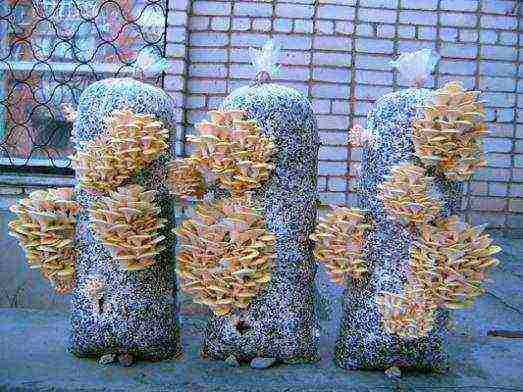 Growing oyster mushrooms at home on the balcony
Growing oyster mushrooms at home on the balcony
Growing technology for beginners
The bulk of the time it takes to grow mushrooms is spent creating mycelium. However, the advice of experienced mushroom growers suggests that it is better to grow this material on your own. After all, even the best and trusted suppliers fail from time to time. Mycelium can be grown in two ways:
- in the grain substrate;
- on wooden sticks.
The choice depends on what kind of mushrooms you plan to grow.
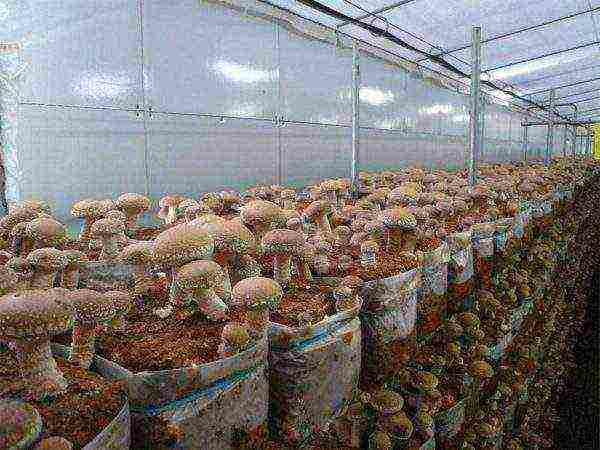 Growing mushrooms on a nutritious substrate
Growing mushrooms on a nutritious substrate
Breeding mycelium
The mycelium is grown in a specific substrate. It is recommended to make sure that its chemical and mineral composition is as similar as possible to that in which mushrooms grow naturally. The composition of this medium must be selected again, depending on the type of mushrooms grown.
For example, shiitake mushrooms feel more comfortable in wood, mushrooms - in compost, but oyster mushrooms prefer straw. With proper care, chopped straw and sawdust can yield any of these types of mushrooms. However, the substrate must be of high quality. This is ensured by its dryness, absence of mold, as well as unpleasant odors and foreign impurities.
Wheat straw is best suited for growing mushrooms. You can also use rye or barley. Oyster mushrooms are allowed to be propagated in sunflower husks. However, only fresh material should be used, since pathogenic bacteria can grow excellently in old ones.
The mycelium is the backbone of a large number of germinated fungal spores. As soon as this base is placed in the substrate, the process of active growth begins. Initially, only the appearance of thin filaments can be observed, which eventually turn into edible mushrooms.
 Mushroom mycelium
Mushroom mycelium
It is worth purchasing high-quality planting material only in specialized stores. Priority should be given to wood containing viable fungal spores. They will be more resistant to disease. Not planted from grain mycelium. You can also buy common mushroom spores. Only in this case it will take more time and effort to grow your crop. The procedure will resemble the cultivation of any crop from seed. It is better for beginners to avoid this method.
To obtain the maximum yield, it is necessary that the mycelium spreads as thoroughly as possible in the compost. To do this, you need to keep the planting warm. They can be heated using a special electric pillow. Heat is needed only during the incubation period. Once the mushrooms are in the growing phase, it is best to keep them cool. A glazed and insulated balcony is well suited for this.
When growing mushrooms in residential premises, the maturation phase must be avoided. Otherwise, the spores released into the air can provoke allergic reactions and even asthma.
As a rule, seedlings appear in the third week after planting the mycelium. Readiness for harvesting is determined by the hat. You need to cut off ready-made mushrooms only with a knife, so as not to injure those that are still in the soil and are just preparing to give a crop. The ready-made collection can be used both immediately and after preliminary freezing.
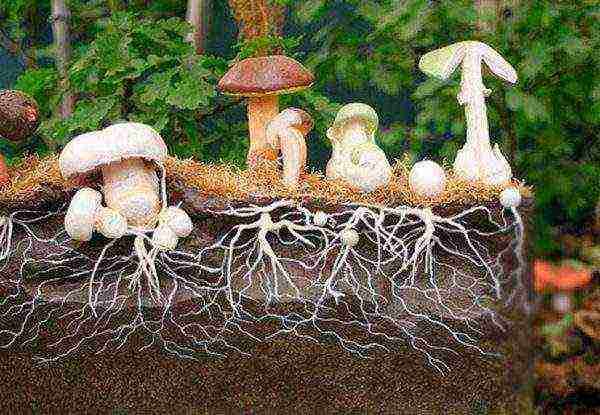 Sectional diagram of mushroom growth from mycelium
Sectional diagram of mushroom growth from mycelium
Other ways to grow mushrooms at home
In addition to the main ones, there are also additional ways of growing mushrooms. True, they do not bring such a large-scale result and are used mainly by children as experiments.For example, some types of mushrooms can be grown on logs. For this logs up to half a meter long are cut from hardwood. This must be done at least 2 weeks before settling with mycelium.
In the resulting blank, holes are made in a checkerboard pattern at a distance of 10 cm. After that, the sticks with mycelium must be sealed. A hammer can be used for this procedure.
Before starting work, you must disinfect your hands and make sure that there is no debris in the holes.
The logs filled with mycelium are placed in the basement and wait until it fills the entire space. The procedure is lengthy and can take up to 1 year. Temperature and humidity are considered key conditions.
A known method of growing mushrooms on coffee grounds. It contains many trace elements:
- manganese;
- potassium;
- magnesium;
- nitrogen.
 Growing mushrooms on stumps
Growing mushrooms on stumps
This environment is ideal for oyster mushrooms. In addition, the coffee grounds do not need to be sterilized again. The disadvantage of this method is that it is very difficult to get a large amount of freshly drunk cake at home. We'll have to ask him at the nearest cafe. The growing container can be regular freezer bags or ice cream containers.
The mycelium must be mixed with the cake, and then the container must be tightly closed. It can be stored under the sink. Germination time will be about 1 month. Once the surface is white, cut a small hole in the top of the bag. Through it, it is necessary to spray with water 2 times a day. After a week, you can see how small mushrooms begin to grow.
Growing porcini mushrooms and other species at home for beginners is a very exciting and useful activity. The needs of your family can be fully satisfied, even without special skills and large areas. The main thing is patience and a desire to see the result. After all, you can grow them all year round!


